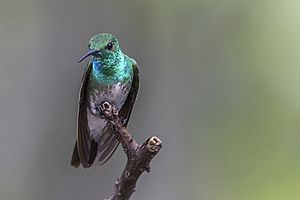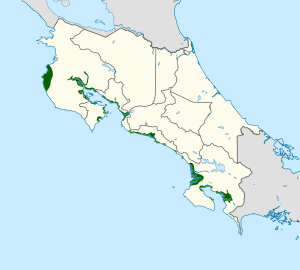Mangrove hummingbird facts for kids
Quick facts for kids Mangrove hummingbird |
|
|---|---|
 |
|
| Conservation status | |
| Scientific classification | |
| Genus: |
Amazilia
|
| Species: |
boucardi
|
 |
|
| Range | |
| Synonyms | |
|
Polyerata boucardi |
|
The mangrove hummingbird (Amazilia boucardi) is a tiny, colorful bird that lives only in Costa Rica. It's an endangered species, which means there aren't many left in the wild. These special hummingbirds are known for living mainly in mangrove forests along Costa Rica's Pacific coast. They belong to a group of hummingbirds called "emeralds."
Contents
How Scientists Name Animals
Scientists give every animal a unique name. This helps everyone know exactly which animal they are talking about. The mangrove hummingbird was first described in 1877 by a French scientist named Étienne Mulsant. He studied a specimen, which is a sample, collected by Adolphe Boucard in Costa Rica.
Mulsant first placed this new bird in a group called Arena. He gave it the name Arena boucardi to honor the person who collected it, Boucard. Later, scientists moved it to the group Amazilia. This group name comes from an Inca heroine in an old novel. The mangrove hummingbird is a unique species, meaning there are no different types or subspecies of it.
What Does It Look Like?
The mangrove hummingbird is a small bird, about 9.5 to 11 centimeters (3.7 to 4.3 inches) long. It weighs around 4.5 grams (0.16 ounces), which is about the same as two pennies!
Both male and female mangrove hummingbirds have a medium-sized beak that curves slightly downwards. The top part of their beak is black, and the bottom part is reddish with a dark tip.
Color Differences
Adult males are very colorful. Their upper body and sides are a shiny golden to bronze-green. Their chin, throat, and chest are a sparkling bluish-green. They have white stripes near the end of their chin feathers. Their belly is whitish, and the feathers under their tail are white. Their tail is slightly forked and bronzy-green, with the outer feathers having dark edges and tips.
Adult females look similar to males but have less green on their underparts. The tips of their outermost tail feathers are grayish. Young birds look like adult females but are more grayish on their underside.
Sounds They Make
These hummingbirds make a soft "djt" sound. It's a quick sound that goes down in pitch, almost like a rapid, descending twitter.
Where Do They Live?
The mangrove hummingbird lives only along the Pacific coast of Costa Rica. It doesn't move around much, staying in one area. These birds prefer to live in large areas of tea mangrove trees, especially Pelliciera rhizophorae. Sometimes, they also live in nearby forests that are growing back after being cut down. Their habitat is not found everywhere along the coast; it's spread out in different patches.
How They Behave
What Do They Eat?
Mangrove hummingbirds mostly drink nectar from mangrove flowers. Nectar is a sweet liquid that plants make. They have also been seen feeding on nectar from other plants like Inga, Heliconia, and Maripa in forest clearings near mangroves. Besides nectar, they also eat small insects.
Reproduction and Life Cycle
The breeding season for the mangrove hummingbird is from October to February. The female builds a cup-shaped nest using soft plant fibers, like cotton-like material from the balsa tree (Ochroma pyramidale). She uses spiderwebs to hold the nest together and decorates the outside with lichens.
The nest is usually placed on a mangrove twig, about 1 to 4 meters (3 to 13 feet) above the water. The female lays two eggs and sits on them to keep them warm. However, scientists don't know exactly how long it takes for the eggs to hatch or for the young birds to be ready to fly.
Why They Are Endangered
The IUCN (International Union for Conservation of Nature) first listed the mangrove hummingbird as "Threatened." Then, in 1994, it became "Vulnerable," and since 2000, it has been listed as "Endangered." This means it's at a very high risk of disappearing forever.
There are only an estimated 1,500 to 7,000 adult mangrove hummingbirds left. Their numbers are believed to be going down. The biggest problem is that their mangrove habitat is being destroyed. People cut down mangroves to make salt, farm shrimp, produce charcoal, and build homes. Even though cutting mangroves is against the law in Costa Rica, it often happens anyway.
Building roads and dikes also harms their habitat by changing how water flows in the mangrove areas. Pollution, especially from the city of Puntarenas near the Golfo de Nicoya, also damages the mangrove forests. Luckily, some small parts of their habitat are protected in special reserves.
See also
 In Spanish: Amazilia manglera para niños
In Spanish: Amazilia manglera para niños



